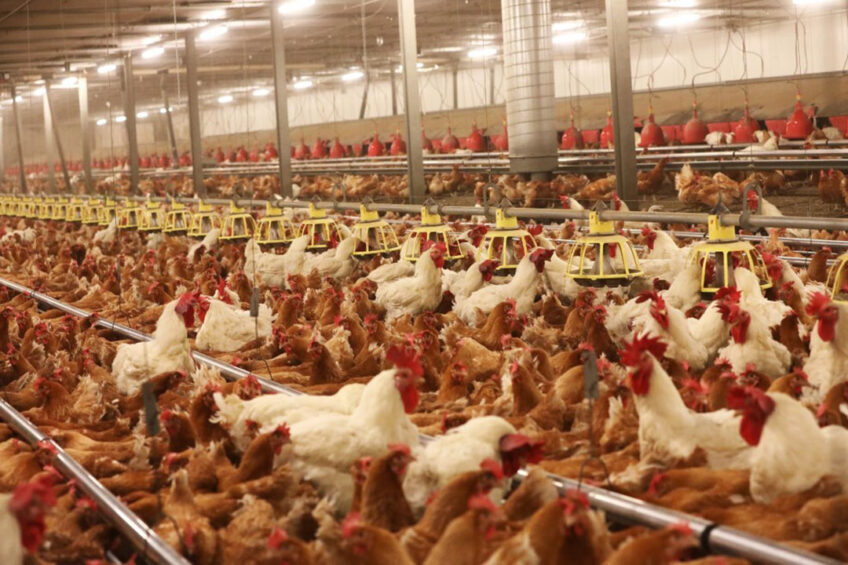Mineral source in parent feed affects broiler growth and bone development

There are various sources of minerals. Most poultry feeds use inorganic minerals, such as monocalcium phosphate or chalk. However, it is also possible to use organic minerals in which the minerals are bound to an amino acid or a protein. This increases mineral absorption in the intestine, making more minerals available to the animals.
If organic minerals work for broilers, this could also be the case for parent stock, leading to more minerals ending up in the hatching egg which would then also be available for the embryo. If more minerals are available in the hatching egg, this could lead to better embryonic bone development and fewer leg problems in the broilers.
The effects of different mineral sources in parent feed on bone development in broilers have hardly been studied and this has only been examined for regular broilers and not for slower-growing broilers. This is why Wageningen University & Research conducted a study on the mineral source (organic or inorganic) in parent feed in relation to the growth and bone development of both regular and slower growing broilers. Chicks from parent stock fed with organic minerals were expected to have stronger bones due to greater mineral density.
Experiment
In this study, 120 Ross 308 and 120 Hubbard JA 57 parent birds, along with 12 males per breed, were fed a breeder diet for 10 weeks containing minerals (calcium, phosphorus, zinc, manganese, copper, iron and selenium) in either inorganic or organic form. This resulted in 4 treatments: Ross Inorganic, Ross Organic, Hubbard Inorganic and Hubbard Organic.
After 10 weeks on the different feeds, eggs were collected and analysed for mineral concentration. In addition, some eggs were incubated. A number of day-old chicks were analysed for mineral concentration in the body.
Of the offspring, 384 males were set up in 32 pens measuring 1.25×2.00 metres, each with 12 chicks. The temperature was 32°Celsius (C), which dropped to 22°C on day 25 and beyond. A light schedule of 24 hours per day was used for the first 3 days after set-up, after which the chicks received 16 hours of light per day. Ross chicks were kept until day 42 and Hubbard chicks until day 49. Chicks were fed unrestricted with a 3-phase feeding schedule. The chicks were vaccinated against Infectious Bronchitis and on day 11 against Newcastle disease.
Measurements
The chicks were weighed individually at set-up and then on days 10, 14, 21, 28, 35, 42 and 49. Feed intake was determined for days 0-14, 14-35, 35-49 and over the entire growth period. The feed conversion was also calculated for these periods.
At a body weight of approximately 2,600 g (day 38 for the Ross chicks and day 49 for the Hubbard chicks), 3 chicks per pen were selected. The left leg of these chicks was assessed and assigned a score by a vet for leg problems, while the tibia was removed from the right leg for further examination.
The weight, length, volume, mineral content and mineral density of the tibias were determined. Finally, the same tibias were broken to determine the force required to break these bones. Stronger bones with more minerals need more force to be broken and are therefore more able to support the weight of the chicks.
Results
On average, the hatching rate of the hatching eggs was 86% of the fertilised eggs. This did not differ between the feed treatments of the parent stock. No effects of the mineral source in the parent stock feed on chick quality at hatching were found either.
The mineral concentration in the eggs and in the day-old chicks was hardly influenced by the mineral source provided to the parent stock. This was contrary to expectations. However, the mineral source in the parent feed had a major effect on the growth of the Hubbard broilers, while this was not the case for the Ross broilers.
In the Hubbard chicks, the difference in body weight on day 49 between the inorganic and organic parent feed was 132 g (Table). Feed intake and feed conversion were not influenced by the mineral source of the parent stock.
The effects of the mineral source in the parent feed on the tibias were clear. Chicks from parent stock fed on organic minerals had better developed bones: they had thicker bones with a better mineral density and with a higher breaking strength. For some tibia traits this was only observed in the Hubbard chicks and not in the Ross chicks, while for other tibia traits this was true for both the Hubbard and the Ross chicks.
Better bone development is positive for bearing the animals’ weight and could result in fewer leg problems. However, the latter was not found in this study. The percentage of chicks with leg problems was very small in this experiment and no differences were found between the 2 mineral sources in the feed of the parent stock.
Clear effect
Organic minerals in parent feed had a positive effect on the quality of the tibia of their offspring (broilers) for both Ross and Hubbard. This effect was greater in the slower-growing chicks. A clear effect on growth was also found here. The reason it was particularly visible in Hubbard chicks may have to do with the lower feed intake of the parent stock but it is also possible that we are not yet fully aware of the optimum mineral levels in the feed of slower growing parent stock.
Because the mineral content in both the eggs and the day-old chicks hardly differed, it is not clear how the effects of organic minerals in the parent feed affect the broilers. This will have to be further researched.












